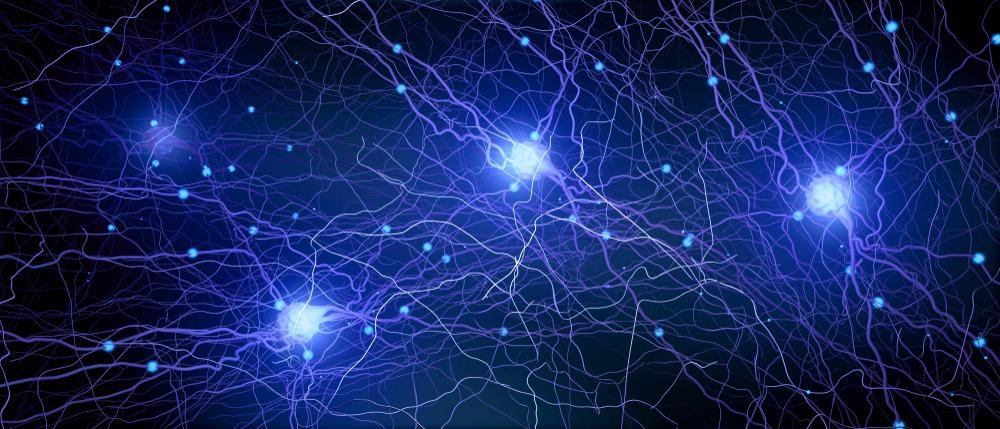Scientists have recently designed an artificial flexible sensory nerve capable of neural coding, tactile sensing, and performing synaptic processing functions. Interestingly, this device does not depend on algorithms or computing resources. The study is available in Advanced Science.

Study: A Flexible Artificial Sensory Nerve Enabled by Nanoparticle-Assembled Synaptic Devices for Neuromorphic Tactile Recognition. Image Credit: Christoph Burgstedt/Shutterstock.com
Tactile Perception and Recognition in Humans
In humans, tactile recognition and perception have been associated with the determination of strength and dynamics of sensory stimulations, which are subjected to the skin via touch (active or passive). The external stimuli or touch is perceived by sensory receptors, which are present on the skin, and are encoded as neural spikes.
These spikes are managed by neurons and synapses, by various processes, such as amplification, adaptation, and memory, and subsequently transmitted to the cerebral cortex. The cerebral cortex is involved with high-level functions, including identification, classification, and perceptual learning.
Because of tactile perception, humans can perform delicate grasping, distinguish between varied textures, and identify different objects based on their tactile features and patterns.
Neuromorphic Electronics
Scientists believe incorporating tactile functions in prosthetics, robotics, and other interactive systems would substantially improve an individual’s cognitive skills when coming across unstructured environments or maneuvering unidentified objects. Advancements in neuromorphic electronics have immensely helped design artificial tactile sensory systems.
Scientists stated that an artificial afferent nerve, which comprises organic synaptic transistors and pressure sensor arrays, is capable of distinguishing Braille characters. This is based on an optoelectronic afferent nerve output (sensor signals) as optical spikes that are processed via software algorithm and detect touch and recognize handwriting.
Some techniques used for processing tactile data obtained from the synaptic device are machine learning algorithms and deep learning. Therefore, these synaptic electronics require additional computing processors, and the tactile recognitions are not performed in real-time.
Nano-based Neuromorphic Tactile Recognition Device - A New Study
In a new study, scientists developed a flexible artificial sensory nerve that can perform real-time neuromorphic tactile recognition. This tactile sensor exhibited high sensitivity and linear response for tactile sensing performance. A flexible synaptic transistor was associated with sensory processing based on neural sensitivity and sensory memory.
Scientists designed the synaptic device using a simple technique associated with the self-assembly of nanoparticles (NP) that can produce continuous and uniform films of NP on arbitrary substrates. Importantly, the tactile data was processed directly by the device without requiring external algorithms or computing resources. Furthermore, the synaptic device also did not require memory erasing or operation of state resetting.
In this study, the synaptic device is an ion-gel gated transistor composed of interdigitated electrodes, a chitosan-based electrolyte placed on a polyimide flexible substrate, and a self-assembled NP channel. Researchers stated that the technique of interfacial self-assembly of NP is an efficient and low-cost fabrication process. In this study, researchers used colloidal amphiphilic zinc oxide NPs.
The tactile sensor was designed based on the lamination of the pressure-sensitive layer, which was composed of carbon nanotubes (CNTs) and room-temperature-vulcanizing (RTV) latex on a polyimide film coated with gold electrodes. The interdigitated electrodes were bridged by a conductive sensing layer.
The authors stated that the flexible artificial sensory nerve processed stimuli similar to signal-transmission and had processing characteristics associated with the biological tactile sensory system. The authors of this study emphasized that their simplified design of the artificial sensory system has substantially elevated the neuromorphic perception capabilities of the device. The device output, i.e., synaptic weight and spike pulse number, are classified for real-time intelligent tactile recognition during robotic manipulation and tactile interaction.
Hardness is one of the most important characteristics of an object that humans learn via touch. In this study, the tactile recognition abilities of the new device were assessed by its capacity to identify the hardness of a material during robotic slow grasp and quickly release it.
The contact force between the object and finger during a touch was assessed initially by the tactile sensor followed by the synaptic device that was attached to the robotic fingers. The tapping pattern was studied to evaluate the tactile interaction capacity of the device.
The authors revealed that during the grasping of porous material with low hardness, the postsynaptic current (PSC) exhibited inconsistencies. This might be due to the release of compressive pressure on the material.
Conclusion
This study provides a guideline for developing a neuromorphic sensory system that possesses human-like cognitive functions. As the newly developed synaptic device and tactile sensor are both flexible, they can be incorporated into a wide range of wearable electronics and robotics.
One of the major advantages of this device is that neuromorphic tactile recognition is directly obtained at the device level without relying on an algorithm or computing resource. In the future, the authors will focus on miniaturization and optimization of the S-encoding circuit to develop flexible electronics with tunable synaptic plasticity and long-term memory in the synaptic device.
Reference
Jiang, C. et al. (2022) A Flexible Artificial Sensory Nerve Enabled byNanoparticle-Assembled Synaptic Devices forNeuromorphic Tactile Recognition. Advanced Science. https://doi.org/10.1002/advs.202106124
Disclaimer: The views expressed here are those of the author expressed in their private capacity and do not necessarily represent the views of AZoM.com Limited T/A AZoNetwork the owner and operator of this website. This disclaimer forms part of the Terms and conditions of use of this website.